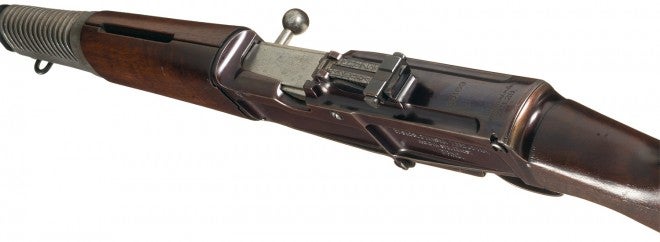The Czech Republic has always been a nation that hits above its weight in the small arms field. Despite being a relatively small country with a somewhat checkered history, it has consistently put out high quality, innovative firearms that compete very well with those offered by much larger and older nations. For having risen from the ashes of the shattered Austro-Hungarian Empire, the Czechs have done quite well.
In fact, they can lay claim to one design in particular that, while obscure, is arguably the most historically significant Czech rifle, the ZH-29. I will talk more about why it was so important below, but first, we can get acquainted with the rifle itself, which is thoroughly unique. Below is embedded a video recorded and uploaded by Ian of Forgotten Weapons, of the field strip of a ZH-29 up for sale at Rock Island Auction Company’s April auction:
Four years ago, FW also recorded and uploaded a shooting video with the ZH-29:
So what makes the ZH-29 so special? Well, it was a combination of weight and timing.
John D. Pedersen was until that point the premier US small arms designer, and by far the one whose ideas influenced the Army’s Ordnance Department. Pedersen asserted – with a considerable degree of evidence at his back – that a military selfloading rifle that met all the requirements could not be designed in the full-power rifle cartridge. It was accepted as fact by the Ordnance Department that a satisfactory full-caliber rifle would weigh at least ten and a half pounds, and development of Pedersen’s knuckle-retarded blowback rifle and his .276 caliber cartridge proceeded in the pursuit of a lighter weapon.
Until August of 1929.
As its name implies, the ZH-29 was designated as such in the year 1929, and was submitted to trials worldwide to try to gain acceptance with nations around the globe. One ZH-29 was sent to the US for testing in July of that year, and was tested a month and a half later.
The ZH-29 tested was chambered for the 7.9mm German round, and weighed in at a mere 8 pounds 13 ounces. Though it did not meet US requirements (being magazine-fed, and a little ungainly), it worked well and impressed the testers. As a result, the myth of “10 1/2 pounds” was shattered. Although John Garand had been commissioned to produce a .30 caliber variant of his design as early as 1926, it was not ready until after the ZH-29 was tested.


Due to misunderstandings of how the development of US selfloading rifles preceded before World War I, the ZH-29 has often been overlooked in its importance to the program. The key idea behind Pedersen’s .276 caliber was that a satisfactory self-loading rifle could not be developed for the larger caliber. Without it, all of the other benefits of the round (lighter weight, lower recoil, lower resource consumption, etc) seemed, to Ordnance, trivial. What was really wanted by those in power was a self-loading replacement for the 1903 in the standard caliber, but Pedersen had cleverly (and not without reason) convinced them that this was impossible.
With the advent of rifles in full-caliber rounds that beat the target weight of nine and a half pounds, Pedersen’s ideas fell out of favor. After the 1929 tests, Garand was given more time to perfect his .30 caliber T1 rifle, which eventually led to the rifle US GIs would use throughout World War II, the M1. Without the ZH-29, Garand might not have been given as much leeway to work on his full-caliber rifle, and it’s not at all clear that the .276 rifle concept could have on its own weathered the coming Great Depression. While we can only speculate as to what might have happened had the ZH-29 not been tested by the Americans in the late Summer of 1929, it came at a critical juncture in the history of selfloading rifles.
Without it, would the US have entered World War II with only bolt-action rifles, like the other nations of the world? Considering the narrow margin by which the M1 rifle was adopted, this is not an outlandish idea.
The hypothesis that the ZH-29 rifle was the first to convince the Ordnance Deparment of the feasibility of full caliber selfloading rifles is presented in Bruce Canfield’s fully comprehensive volume The M1 Garand Rifle, and is credited to Robert Seijas. I highly recommend this book to anyone interested in the subject.
 Your Privacy Choices
Your Privacy Choices
